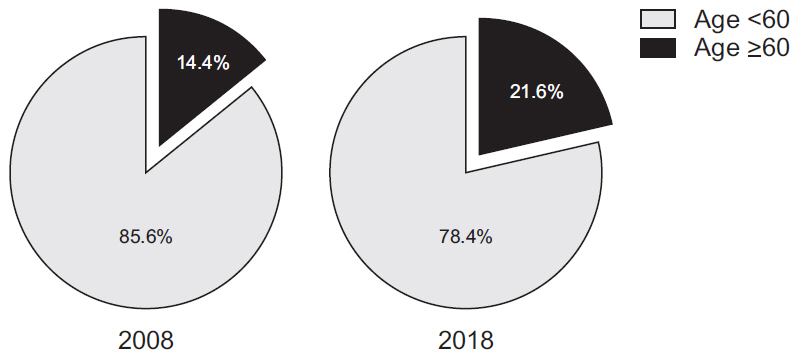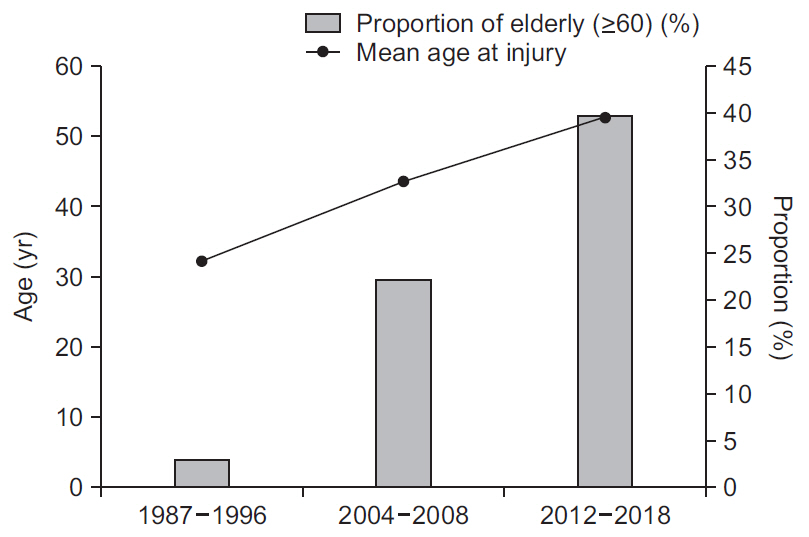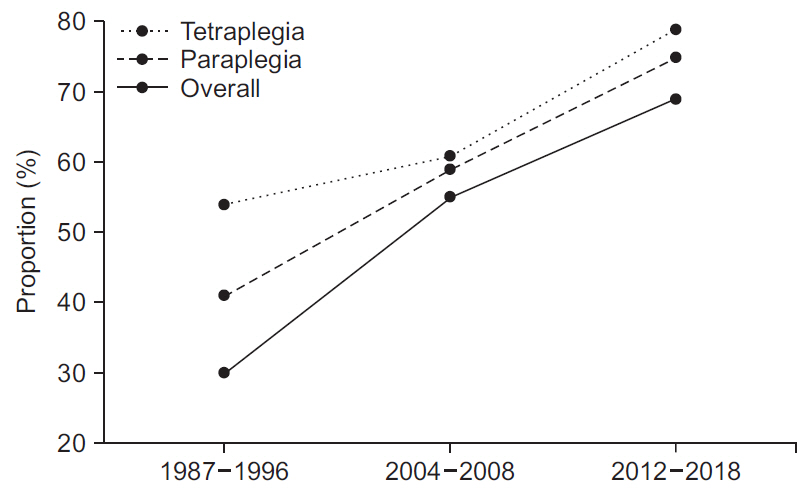Ann Rehabil Med.
2021 Feb;45(1):7-15. 10.5535/arm.20148.
Epidemiology of Spinal Cord Injury: Changes to Its Cause Amid Aging Population, a Single Center Study
- Affiliations
-
- 1Department of Physical Medicine and Rehabilitation, Inje University Ilsan Paik Hospital, Goyang, Korea
- KMID: 2513225
- DOI: http://doi.org/10.5535/arm.20148
Abstract
Objective
To investigate the epidemiologic and demographic characteristics of patients with spinal cord injury (SCI) who were admitted to a department of rehabilitation of a university hospital.
Methods
This was a descriptive cross-sectional study. Medical records including sex, age at injury, type of disability, traumatic or non-traumatic etiology and presence of ossification of posterior longitudinal ligament (OPLL) of patients with SCI who were admitted to the department of rehabilitation between 2012 and 2018 were reviewed.
Results
Of the 221 cases of SCI, 161 were traumatic and 60 were non-traumatic. The mean age at injury was 52.8 years. People aged 40–49 years showed highest proportion among overall SCI patients (19.0%). The proportion of male patients was higher in traumatic SCI at 4.96:1 than in non-traumatic SCI at 1.30:1. The most common cause of traumatic SCI was falling off (37.3%), followed by motor vehicle crash (35.4%) and tripping over (19.3%). Meanwhile, the most common cause of non-traumatic SCI was neoplasm (35.0%). Tripping over was the leading cause of traumatic SCI in patients aged ≥60 years (42.6%). A high proportion of traumatic SCI patients were found to have underlying OPLL (26.1%), particularly those who were injured by tripping over (64.5%).
Conclusion
The mean age of SCI patients was higher than that of previous studies. Falls was the single most common cause of traumatic SCI, and tripping over was the most common cause of injury in the elderly patients. OPLL was prevalent in patients who were injured from tripping over.
Figure
Cited by 2 articles
-
Trends in the Incidence and Etiology of Non-Traumatic Spinal Cord Injury in Korea: A Nationwide Population-Based Study From 2007 to 2020
Yoonjeong Choi, Ja-Ho Leigh, Jooeun Jeon, Goo Joo Lee, Hyung-Ik Shin, Moon Suk Bang
J Korean Med Sci. 2023;38(18):e158. doi: 10.3346/jkms.2023.38.e158.Epidemiology and Assessment of Traumatic Spinal Cord Injury With Concomitant Brain Injury: An Observational Study in a Regional Trauma Center
Tae Woong Yang, Dong Ho Yoo, Sungchul Huh, Myung Hun Jang, Yong Beom Shin, Sang Hun Kim
Ann Rehabil Med. 2023;47(5):385-392. doi: 10.5535/arm.23054.
Reference
-
1. DeVivo MJ. Causes and costs of spinal cord injury in the United States. Spinal Cord. 1997; 35:809–13.
Article2. Price C, Makintubee S, Herndon W, Istre GR. Epidemiology of traumatic spinal cord injury and acute hospitalization and rehabilitation charges for spinal cord injuries in Oklahoma, 1988-1990. Am J Epidemiol. 1994; 139:37–47.
Article3. Sekhon LH, Fehlings MG. Epidemiology, demographics, and pathophysiology of acute spinal cord injury. Spine (Phila Pa 1976). 2001; 26(24 Suppl):S2–12.
Article4. Sohn S, Kim J, Chung CK, Lee NR, Sohn MJ, Kim SH. A nation-wide epidemiological study of newly diagnosed primary spine tumor in the adult Korean population, 2009-2011. J Korean Neurosurg Soc. 2017; 60:195–204.
Article5. Pickett GE, Campos-Benitez M, Keller JL, Duggal N. Epidemiology of traumatic spinal cord injury in Canada. Spine (Phila Pa 1976). 2006; 31:799–805.
Article6. Cook DJ, Cusimano MD, Tator CH, Chipman ML. Evaluation of the ThinkFirst Canada, Smart Hockey, brain and spinal cord injury prevention video. Inj Prev. 2003; 9:361–6.7. Shults RA, Sleet DA, Elder RW, Ryan GW, Sehgal M. Association between state level drinking and driving countermeasures and self reported alcohol impaired driving. Inj Prev. 2002; 8:106–10.
Article8. Wesner ML. An evaluation of Think First Saskatchewan: a head and spinal cord injury prevention program. Can J Public Health. 2003; 94:115–20.9. Devivo MJ. Epidemiology of traumatic spinal cord injury: trends and future implications. Spinal Cord. 2012; 50:365–72.
Article10. DeVivo MJ, Chen Y. Trends in new injuries, prevalent cases, and aging with spinal cord injury. Arch Phys Med Rehabil. 2011; 92:332–8.
Article11. Jackson AB, Dijkers M, Devivo MJ, Poczatek RB. A demographic profile of new traumatic spinal cord injuries: change and stability over 30 years. Arch Phys Med Rehabil. 2004; 85:1740–8.
Article12. National Spinal Cord Injury Statistical Center. 2019 annual report - complete public version. Birmingham, AL: National Spinal Cord Injury Statistical Center;2019.13. Ning GZ, Wu Q, Li YL, Feng SQ. Epidemiology of traumatic spinal cord injury in Asia: a systematic review. J Spinal Cord Med. 2012; 35:229–39.
Article14. Han ZA, Lee BS, Kim W, Lee SJ, Im HJ, Kim C, et al. People with spinal cord injury in Korea. Am J Phys Med Rehabil. 2017; 96(2 Suppl 1):S83–5.
Article15. Park CI, Shin JC, Kim SW, Jang SH, Chung WT, Kim HJ. Epidemiologic study of spinal cord injury. J Korean Acad Rehabil Med. 1999; 23:267–75.16. Shin JC, Kim DH, Yu SJ, Yang HE, Yoon SY. Epidemiologic change of patients with spinal cord injury. Ann Rehabil Med. 2013; 37:50–6.
Article17. National Rehabilitation Center. National Rehabilitation Center SCI Database. Seoul, Korea: National Rehabilitation Center;2014.18. Ackery A, Tator C, Krassioukov A. A global perspective on spinal cord injury epidemiology. J Neurotrauma. 2004; 21:1355–70.
Article19. Lee BB, Cripps RA, Fitzharris M, Wing PC. The global map for traumatic spinal cord injury epidemiology: update 2011, global incidence rate. Spinal Cord. 2014; 52:110–6.
Article20. Eurostat. Population structure and ageing 2008-2018. Luxembourg, Luxembourg: Eurostat;2018.21. Statistics Korea. 2018 senior statistics. Daejeon, Korea: Statistics Korea;2018.22. He W, Goodkind D, Kowal P. An aging world 2015. Washington, DC: US Census Bureau;2016.23. Sohn S, Chung CK, Yun TJ, Sohn CH. Epidemiological survey of ossification of the posterior longitudinal ligament in an adult Korean population: three-dimensional computed tomographic observation of 3,240 cases. Calcif Tissue Int. 2014; 94:613–20.
Article24. Inamasu J, Guiot BH, Sachs DC. Ossification of the posterior longitudinal ligament: an update on its biology, epidemiology, and natural history. Neurosurgery. 2006; 58:1027–39.
Article25. Jin BH, Kim YS. Ossification of spinal ligaments. J Korean Neurosurg Soc. 1991; 20:875–84.26. Fujimori T, Le H, Hu SS, Chin C, Pekmezci M, Schairer W, et al. Ossification of the posterior longitudinal ligament of the cervical spine in 3161 patients: a CT-based study. Spine (Phila Pa 1976). 2015; 40:E394–403.27. Saetia K, Cho D, Lee S, Kim DH, Kim SD. Ossification of the posterior longitudinal ligament: a review. Neurosurg Focus. 2011; 30:E1.
Article28. Chamberlain JD, Deriaz O, Hund-Georgiadis M, Meier S, Scheel-Sailer A, Schubert M, et al. Epidemiology and contemporary risk profile of traumatic spinal cord injury in Switzerland. Inj Epidemiol. 2015; 2:28.
Article29. DeVivo MJ, Biering-Sorensen F, New P, Chen Y; International Spinal Cord Injury Data Set. Standardization of data analysis and reporting of results from the International Spinal Cord Injury Core Data Set. Spinal Cord. 2011; 49:596–9.
Article30. Knutsdottir S, Thorisdottir H, Sigvaldason K, Jonsson H Jr, Bjornsson A, Ingvarsson P. Epidemiology of traumatic spinal cord injuries in Iceland from 1975 to 2009. Spinal Cord. 2012; 50:123–6.
Article31. Halvorsen A, Pettersen AL, Nilsen SM, Halle KK, Schaanning EE, Rekand T. Epidemiology of traumatic spinal cord injury in Norway in 2012-2016: a registry-based cross-sectional study. Spinal Cord. 2019; 57:331–8.
Article32. Chen Y, Tang Y, Allen V, DeVivo MJ. Fall-induced spinal cord injury: external causes and implications for prevention. J Spinal Cord Med. 2016; 39:24–31.
Article33. Ministry of the Interior and Safety. Statistics of residence registration population 2008-2018. Sejong, Korea: Ministry of the Interior and Safety;2019.34. Kim TJ, Bae KW, Uhm WS, Kim TH, Joo KB, Jun JB. Prevalence of ossification of the posterior longitudinal ligament of the cervical spine. Joint Bone Spine. 2008; 75:471–4.
Article35. Jain NB, Ayers GD, Peterson EN, Harris MB, Morse L, O’Connor KC, et al. Traumatic spinal cord injury in the United States, 1993-2012. JAMA. 2015; 313:2236–43.
Article
- Full Text Links
- Actions
-
Cited
- CITED
-
- Close
- Share
- Similar articles
-
- The Role of GABA in Spinal Cord Injury
- Pre-injury Treatment of Methylprednisolone in Experimental Spinal Cord Injury
- Epidemiologic Change of Patients With Spinal Cord Injury
- Paraplegia Following Spinal Cord Contusion from an Indirect Gunshot Injury
- Delayed Spinal Cord Injury Following Low Voltage Electrical Accident




